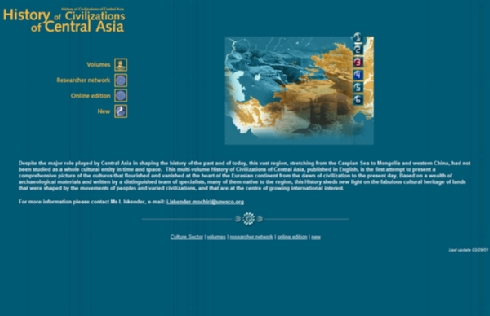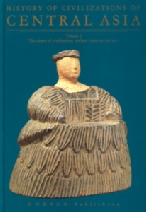Conferences / Congresses
History of Civilizations of Central Asia.
Volumes I - VI
Preface
One of the purposes of UNESCO, as proclaimed in its Constitution, is 'to develop and to increase the means of communication between . . . peoples and to employ these means for the purposes of mutual understanding and a truer and more perfect knowledge of each other's lives'. The History of the Scientific and Cultural Development of Mankind, published in 1968, was a major early response on the part of UNESCO to the task of enabling the peoples of the world to have a keener sense of their collective destiny by highlighting their individual contributions to the history of humanity. This universal history - itself now undergoing a fundamental revision - has been followed by a number of regional projects, including the General History of Africa and the planned volumes on Latin America, the Caribbean and on aspects of Islamic culture. The History of Civilisations of Central Asia, hereby initiated, is an integral part of this wider enterprise.
It is appropriate that the second of UNESCO's regional histories should be concerned with Central Asia. For, like Africa, Central Asia is a region whose cultural heritage has tended to be excluded from the main focus of historical attention. Yet from time immemorial the area has served as the generator of population movements within the Eurasian land-mass. The history of the ancient and medieval worlds, in particular, was shaped to an important extent by the succession of peoples that arose out of the steppe, desert, oases and mountain ranges of this vast area extending from the Caspian Sea to the high plateaux of Mongolia. From the Cimmerians mentioned in Homer's Odyssey, the Scythians described by Herodotus, the Hsiung-nu whose incursions led the Emperors of China to build the Great Wall, the sixth-century Turks who extended their empire to the boundaries of Byzantium, the Khitans who gave their name to ancient Cathay, through to the Mongols who erupted into world history in the thirteenth century under Genghis Khan, the nomadic horsemen of Central Asia to define the limits and test the mettle of the great civilizations of Europe and Asia.
Not is it sufficient to identify the peoples of Central Asia simply with nomadic cultures. This is to ignore the complex symbiosis within Central Asia itself between nomadism and settlement, between pastoralists and agriculturalists. It is to overlook above all the burgeoning of the great cities of Central Asia such as Samarkand, Bukhara and Khiva, which established themselves in the late Middle Ages as outstanding centres of intellectual inquiry and artistic creation. The seminal writings of the philosopher-scientist Avicenna (a native of Bukhara) and the timeless masterpicces of Timurid architecture epitomize the flowering of medieval culture in the steppes and deserts of Central Asia. The civilizations of Central Asia did not, of course, develop in a vacuum. The impact of Islam was pervasive and fundamental. The great civilizations on the periphery of the Eurasian continent likewise exerted an important influence on these lands. For some 1,500 years this arid inland sea - far removed from the earth's true oceans - was crucial as the route along which merchandise (notably silk) and ideas flowed between China, India, Iran and Europe. The influence of Iran - although the core of its civilization lies in south-west Asia - was particularly strong, to the extent that it is sometimes difficult to establish a clear boundary between the civilization of the Iranian motherland and that of the outlying lands of Central Asia. To the rich variety of peoples of Central Asia was thus added a multiplicity of external influences. For century after century, the region experienced the influx of foreign art and ideas, colliding and merging with the indigenous patterns of Central Asia. Migrations and the recurrent shock of military invasion, mingling and displacing peoples and cultures, combined to maintain the vast region in flux.
The systole and diastole of population movements down the ages add to the difficulty of delimiting a region whose topology alone does not prescribe clear boundaries. Thus, when, at the nineteenth session of its General Conference, UNESCO decided to embark on a History of Civilizations of Central Asia the first problem to be resolved was to define the scope of the region concerned. Subsequently, at a UNESCO meeting held in 1978, it was agreed that the study on Central Asia should deal with the civilizations of Afghanistan, north-eastern Iran, Pakistan, northern India, western China, Mongolia and the Soviet Central Asian republics. The appellation 'Central Asia', as employed in this History, refers to this area, which corresponds to a clearly discernible cultural and historical reality.
UNESCO's call to specialists, and particularly to scholars native to the region, to participate in the undertaking met with a wide and generous response. The project was deemed by academics to be an excellent opportunity to draw back the curtain that had veiled Central Asia for so long. However, none were in any doubt as to the huge dimensions of the task. An ad hoc International Scientific Committee was formed in 1980 to plan and prepare the work, which it was agreed should cover, in six volumes, the history of Central Asia from earliest times to the present day. The Committee's initial task was to decide where pre-eminence should be given in the very wide canvas before. In due course, a proper balance was struck and teams of editors and authors were selected.
The preparation of the History of Civilizations of Central Asia is now well advanced. The best resources of research and archaeology have been used to make the work as thorough as possible, and countless annals consulted in major centres throughout the region. It is my sincere wish that this, the first volume, and those that follow will bring instruction and pleasure to readers all over the world.
It remains for me to thank the President, Rapporteur and members of the International Scientific Comrnittee, and the editors, authors and teams of specialists who have collaborated to shed new light on Central Asia with this detailed account of its vital and stirring past. I am sure it will prove a notable contribution to the study and mutual appreciation of the cultures that are the common heritage of mankind.
Federico Mayor, Director-General of UNESCO












